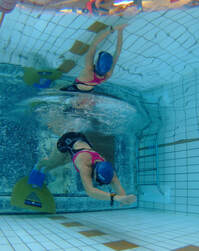Interactive
Before we look at the theory of refraction, let's play with this animation.
From pHET, this is a great way to explore refraction. Play with it, but better still, use the settings to determine variables that determine the amount of refraction.
Don't worry too much about measuring at this stage, just appreciate what factors determine the amount of bending.
Before we look at the theory of refraction, let's play with this animation.
From pHET, this is a great way to explore refraction. Play with it, but better still, use the settings to determine variables that determine the amount of refraction.
Don't worry too much about measuring at this stage, just appreciate what factors determine the amount of bending.
Hopefully you have come to realise that the amount of bending is dependent on the incident angle and the variation between the different media.
You should have also noted that if the wave enters a denser medium, it bends toward the normal. If it enters a less dense medium, it bends away from the normal.
Lets now look at the video
Ensure you take good notes to retain information
Check your understanding
Sample Problem
We are now ready to try a sample problem
Below is a sample problem with a video that explain how to solve it. It is suggested you try the problem beforehand, as this actually aids understanding, even if you are unsure if you are correct.
We are now ready to try a sample problem
Below is a sample problem with a video that explain how to solve it. It is suggested you try the problem beforehand, as this actually aids understanding, even if you are unsure if you are correct.
Here are some problems for you to try, (solutions in the brackets)
- Suppose that light rays traveling through air reach quartz at an angle of 31°. The index of refraction of quartz is 1.54. At what angle do the light rays travel within the quartz? (19.5°)
- A light ray enters a substance from the air at an angle of 35°. The light is refracted inside the substance and travels at an angle of 26°. What is the index of refraction of the substance? (1.308)
- Diamond has an index of refraction of 2.42. If it is immersed in water, which has an index of 1.33, and light rays in the water enter the diamond at a 34° angle, what is the angle of refraction inside the diamond? (17.9°)
- The index of refraction of a substance is 1.83. What is the speed of light in that material? (1.64e8)
- A ray of light strikes a mirror at an angle of incidence of 24°. What is the angle of reflection? (24°)
- A ray of light passes from an unknown substance into the air. If the angle in the unknown substance is 39.0° and the angle in the air is 53.0°, what is the index of refraction of the unknown substance? (1.27)
- A ray of light has an angle of incidence of 25.0° upon the surface of a piece of quartz. What is the angle of refraction? (15.9)
- A beam of light passes from water into polyethylene, index of refraction = 1.50. If the angle in the water is 36.0°, what is the angle in the polyethylene? (30.92)
- Mi-ling makes some hydrogen sulfide, index of refraction = 1.000 644. If Mi-ling measures an angle of 85.000 000° in the hydrogen sulfide, what angle will Mi-ling measure in air if the index of refraction of air is 1.000 292 6? (85.236°)
Total Internal Reflection

In certain cases when light tries to enter a less dense medium, it does not refract, in fact it reflects straight back in
Its the reason why fish tanks can appear like mirrors, and the water surface can appear mirro like from underwater
Total internal reflection is a unique property of refraction as the wave enters a substance of lower refractive index, it reflects back in, obeying the Law of Reflection
Watch the video below to understand this phenomenon, including the underlying mathematical principles.
Its the reason why fish tanks can appear like mirrors, and the water surface can appear mirro like from underwater
Total internal reflection is a unique property of refraction as the wave enters a substance of lower refractive index, it reflects back in, obeying the Law of Reflection
Watch the video below to understand this phenomenon, including the underlying mathematical principles.
Interactive
- Now go back to the interactive above, and adjust the refractive indices so the second one is less then the first. (use the third TAB)
- Manipulate the beam to get total internal reflection.
- Calculate the critical angle and then use the built in protractor to confirm your calculation.
|
Application
A common application of total internal reflection is optic fibres. In the demonstration here, I simulate an optic fibre using a stream of water |
|


